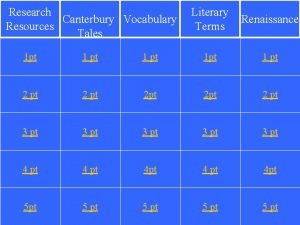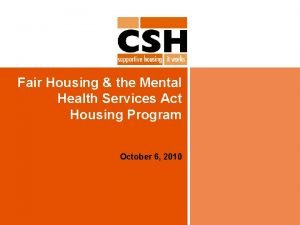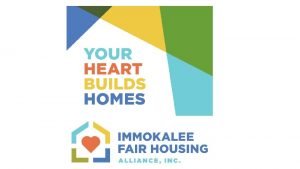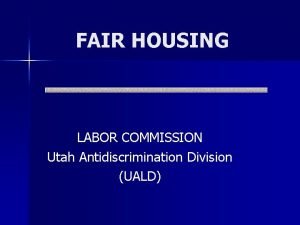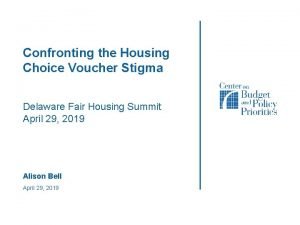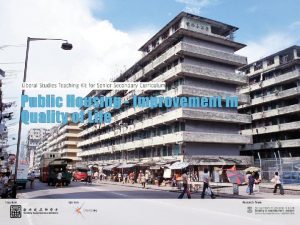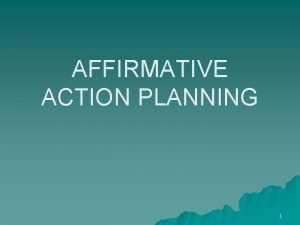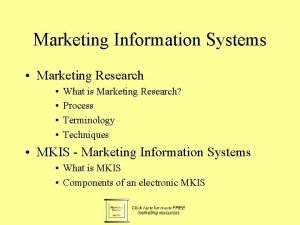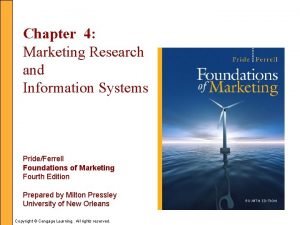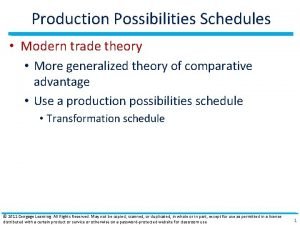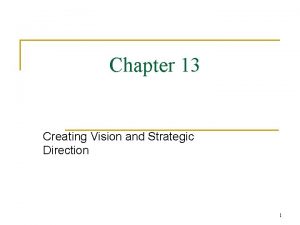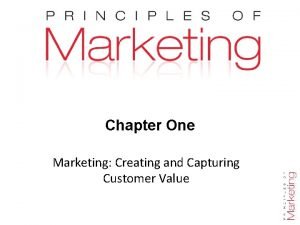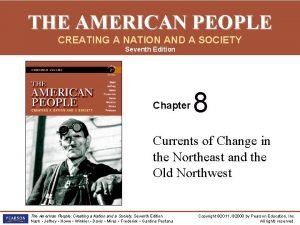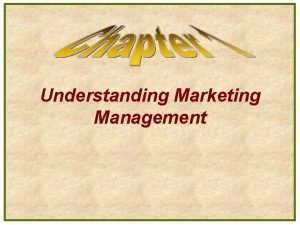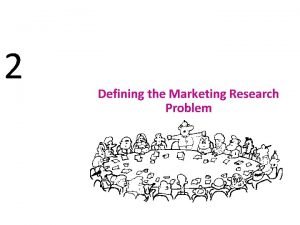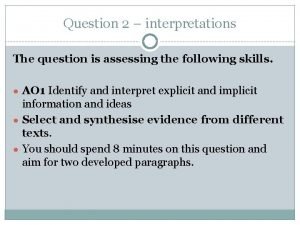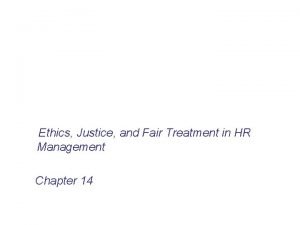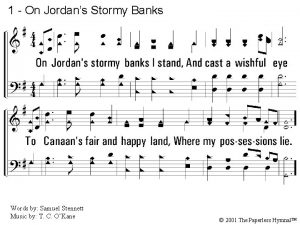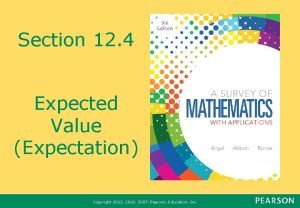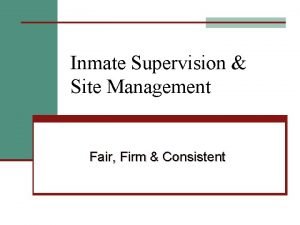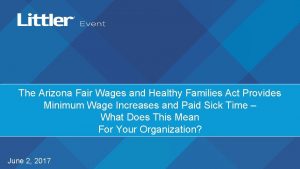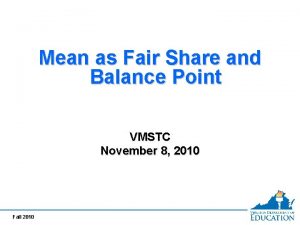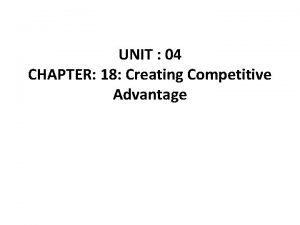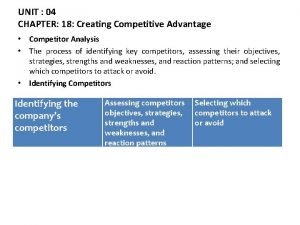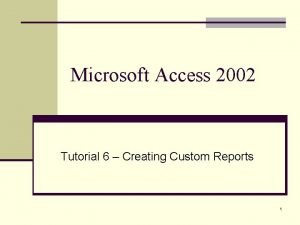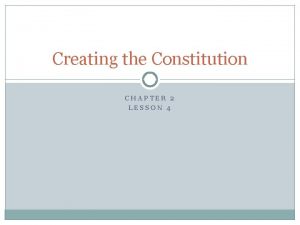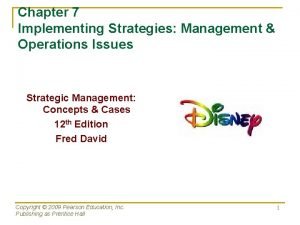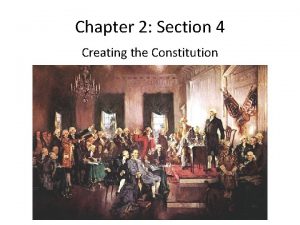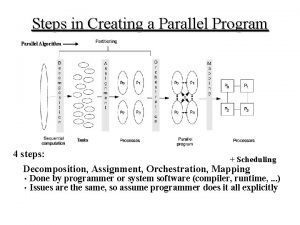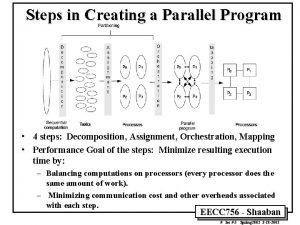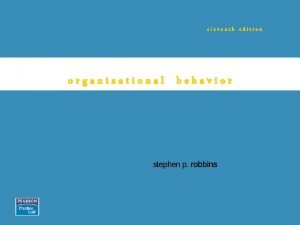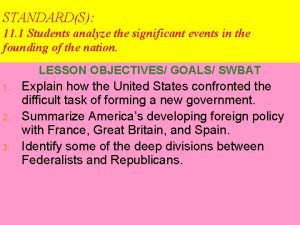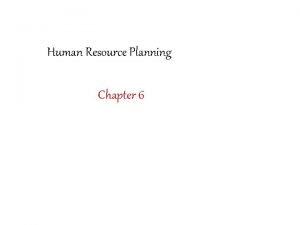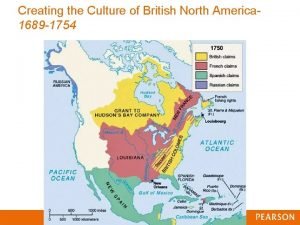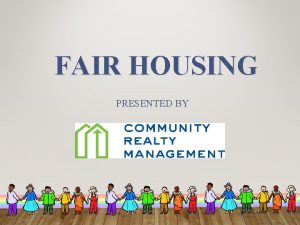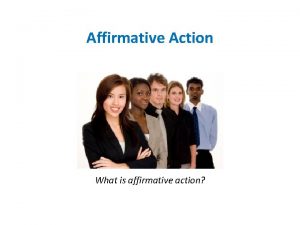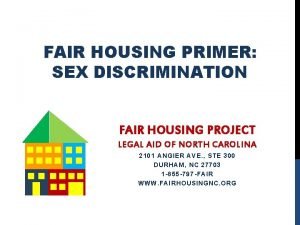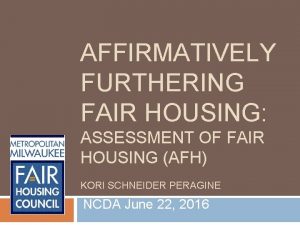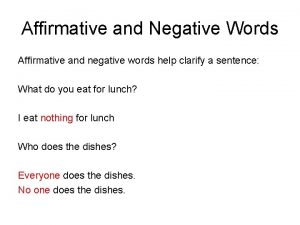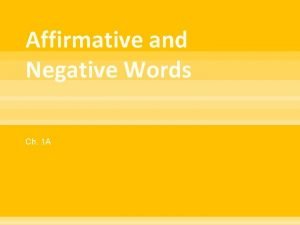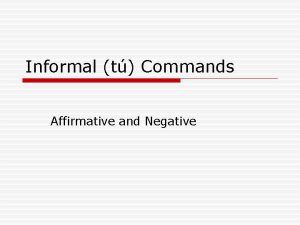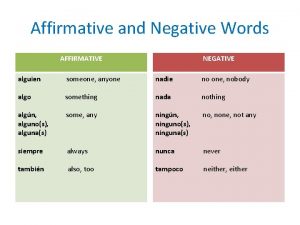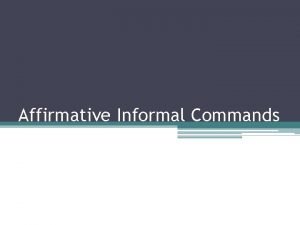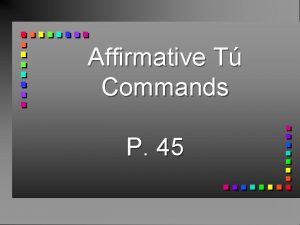Creating an Affirmative Fair Housing Marketing Plan and















































































































- Slides: 111

Creating an Affirmative Fair Housing Marketing Plan and Section 3 Compliance

Agenda • Review of new HUD AFFH Rule • Creating an Affirmative Fair Housing Marketing Plan • AA-5 • Compliance with Section 3

New HUD AFFH Regulation Issued 3

HUD’s New AFFH Regulation • Issued on July 8, 2015; http: //www. huduser. org/portal/affht_pt. html • Purpose of new rule is to provide clearer guidance, standards, and oversight • Integrate AFFH into planning processes

HUD’s New AFFH Regulation • • Regulation is at 24 CFR § § 5. 150 -5. 180 AFFH means: • Take meaningful action to overcome patterns of segregation and foster inclusive communities • • Address significant disparities in housing needs and in access to opportunity • • Transform racial and ethnic areas of poverty into areas of opportunity Replace segregated living patterns with integrated and balanced living patterns Foster and maintain compliance with civil rights and fair housing laws 5

HUD’s New AFFH Regulation • New regulation replaces the Analysis of Impediments to Fair Housing Choice (AI) with an assessment of fair housing issues (AFH) • Assessment requires establishment of fair housing goals and priorities • • Provides data for use in the assessment tool • Once an AFH is completed it must be submitted to HUD for approval Does not mandate specific outcomes but establishes basic parameters 6

HUD’s New AFFH Regulation • To help in creating an AFH, HUD will provide all recipients with data on: • • • Patterns of integration and segregation; • Disproportionate housing needs based on membership in a protected class. Racially and Ethnically Concentrated Areas of Poverty (R/ECAP); Access to education, employment, low-poverty communities, transportation and environmental health; and 7

Who has to Create an AFH • Federal financial recipients—no change in new regulation • Delayed implementation of the new assessment tool until tool approved by OMB for: • • CDBG grantees receiving $500, 000 or less in FY 2015 PHAs with a total of 550 or fewer public housing units and section 8 vouchers, are not designated as troubled and do not have a failing score under the section 8 management assessment program have a delayed requirement to do an AFH 8

HUD’s New AFFH Regulation • Next Steps • New assessment of fair housing (AFH) will be required of recipients creating a Con. Plan on or after January 1, 2017 • Once AFH is completed, must incorporate findings and proposed solutions into subsequent planning documents such as the Con. Plan and Annual Action Plans • Use plans to decide how to use federal financial assistance

HUD’s New AFFH Regulation • Next steps • Create priorities and goals for use of federal funding which overcome problems identified in AFH • • Submit all planning documents to HUD for review and approval. Incorporate this analysis into all planning documents, including PHA plans, which discuss use of federal funding; 10

HOW TO CREATE AN AFHMP Reviewing and completing the AA-5

What is an AFHMP? • Marketing plan • Designed to attract a diverse group of applicants • Defines who is “least likely to apply” • Describes marketing to those “least likely to apply”

Why is an AFHMP Required? • Required by state law-- Conn. Agency Regs. § 837 ee(2)(a) • The affirmative fair housing marketing plan requirements shall apply to all recipients of state funding where such funding is used for the development or rehabilitation of: • Subdivisions or multifamily developments of five or more lots or units; or • Scattered site dwelling units, where the receipt of state funding exceeded, or shall exceed, the development or rehabilitation of five such dwelling units during the year.

Why is an AFHMP Required? • Ensure 20% of units are rented to those least likely to apply • Achieve diversity in housing • Promote integration, overcome segregation

Segregation and People of Color • Two of every three persons of color in Connecticut live in just 15 of the state’s 169 municipalities. • These municipalities house 35% of the State’s entire population. • Put another way, 67% of the State’s population of color lives in 8% of Connecticut’s towns.


Connecticut v. Other Parts of US • Bridgeport ranks 8 th and Hartford ranks 9 th most segregated in the US when looking at White-Latino segregation • Bridgeport ranks 18 th and Hartford ranks 34 th most segregated in the US when looking at White-Black segregation

Why does segregation matter? • High poverty neighborhoods: 81. 1% of African. Americans and 79. 26% of Latinos live in areas with high poverty rates, failing schools, and little access to jobs compared to 44% of Asians and 25. 84% of non-Hispanic Whites.

Why does segregation matter? • Employment: Job growth in Connecticut is occurring outside urban areas in places where few people of color live. • Education: Racial, ethnic, and economic housing segregation contributes to severe disparities in educational outcomes in Connecticut because most school districts assign children to schools by neighborhood.

Why does segregation matter? • Health outcomes: In 2009, the asthma hospitalization rate for the five largest Connecticut cities combined – Bridgeport, Hartford, New Haven, Stamford, and Waterbury – was 35. 3 per 10, 000. This is 3. 4 times greater than the asthma hospitalization rate for the rest of the state combined. • Black children with high rates of elevated blood lead was 2. 7 times that of non-Hispanic White children who were screened.

Segregation of Other Protected Classes • Disability • 20% of people with disabilities in Connecticut are living in 10 municipalities representing just under 6% of the municipalities in the state and 16% of the statewide population • Factors influencing housing choices of people with disabilities such as the availability of certain services, may explain these housing patterns

Covered State Housing Programs • State subsidized housing programs • • • FLEX HOME (state administered federal funds) Housing Trust Fund Rental Housing for the Elderly Congregate Housing for the Elderly

Covered State Housing Programs • State subsidized housing programs (cont’d) • Moderate Rental Housing (including Section 8 moderate rehab and MRD) • • • Affordable (Low Income) Housing Limited Equity Cooperatives – Mutual Housing

State AFHMP Forms and Regulations • AA-5 • www. ct. gov/doh • • Click on Applications CDBG Small Cities Exhibit 6. 1—Fair Housing Action Plan and Resources Conn. Agencies Regs. §§ 8 -37 ee-300— 314

Section 2—Application and Project Identification • Section 2. A— • Basic information including the name of the entity applying for/receiving the housing grant. • Address of the entity, not the housing

Section 2, cont’d • Section 2. B • Number of Units • • Needed to determine how many people should be on a waiting list before marketing again. 1 Price or Rental Range of Units • • Done at the time the AA-5 is completed Must be updated when AA-5 is updated 1 If there is an inadequate number of people least likely to apply and/or less than 3 people per unit must re-market property.

Section 2, cont’d • Section 2. C—Project Information • • • Requests the name of the project; Requests the address of the project; Fill in the county and the census tract in which the housing is located • Will need to know census tract demographics to determine direction of marketing activities • Can find the census tract by putting the address of the property into the Connecticut Opportunity Map

Section 2, cont’d • Section 2. D • Date of initial occupancy • • If this is not an initial AFHMP, give the approximate date of the initial occupancy; Starting dates of advertising/occupancy • • Advertising must begin at least 90 days prior to occupancy If this is not an initial AFHMP, advertising must begin 90 days prior to opening waiting list

Section 2, cont’d • Section 2. E--Managing/Sales Agent Information • To be completed if the applicant/recipient is not going to be implementing the AFHMP, but owners must approve the AFHMP before implementation; • Otherwise indicate Managing/Sales agent is the same as the information provided in 2. A.

Section 2. F • Fill this out after completing Worksheet 1 • Housing Market Area—area (not necessarily the census tract(s), but the entire geographic area) from which a multifamily housing project owner/agent may reasonably expect to draw a substantial number of its tenants. • AFHMP will not be accepted without the designation of the housing market area.

Section 2. F—Cont’d • The “housing market area” includes: 1 • The largest city located in the nearest Primary • • Metropolitan Statistical Area or Areas or Metropolitan Statistical Area or Areas, The regional planning area, and Any other areas which are likely to contain high minority populations and where public transportation or public highways and/or job availability make it likely that minorities might wish to move where the development is located. 1 Sec. 8 -37 ee-302(b)(2)

Section 2. F—Cont’d • Expanded housing market area—If a housing market area is not demographically diverse in terms of race, color, national origin, disability, or familial status, an expanded housing market area may be used. • An expanded housing market area is a larger geographic area that may provide additional diversity.

Section 2. F—Cont’d • Indicate the housing or expanded housing market area in which the housing is/will be located, e. g. , “City of _____” for housing market area, or “City of _____” and “County of _____” for expanded housing market area. • Worksheet 1 will dictate what is put into Section 2. F.

Section 3—Type of Marketing Plan • Must choose 1 • Project plan—will be describing the marketing program for the particular project or subdivision • Single family scattered site—builders must submit individual annual plans based on the racial composition of each census tract where the housing will be built

Section 4—Direction of Marketing Activity • Section 4. A--Defining who is least likely to apply • Complete and submit Worksheet 1 • Will determine if the housing provider needs to use an expanded marketing area

Completing Worksheet 1 • Go to http: //ct. gov/doh • Click on “Policy and Research” and then scroll down to “Connecticut Opportunity Map” • • • Open the Connecticut Opportunity Map Click on “Content” Check off “Population--% Non-White” • Put address of the housing complex into the search bar on the right hand side of the map


Tract ID Total Population White (non-Hispanic) Black or African American (non. Hispanic) Asian (non-Hispanic) Hispanic or Latino All Other Races % Non-White Foreign Born Population % Foreign Born Origin: Europe Origin: Asia Origin: Africa Origin: Latin America Origin: North America Origin: Oceana 09003504100 2120 206 430 27 1, 213 244 90. 3 980 46. 2 31 29 0 920 0 0

Section 4, cont’d • Section 4. A--Completing Worksheet 1 • Asks for the demographic composition of the project, waiting list, census tract, and housing marketing area; • If this is an initial AFHMP, skip the columns requesting the demographic composition of the project and the waiting list.

Worksheet 1—Initial AFHMP—Rehab projects or expansions do not fill out columns 2 and 3 Column 1 Column 2 Demographic Characteristics Project % (If this is an initial AFHMP, skip this column) White American Indian or Alaskan Native Asian Black or African. American Native Hawaiian or Other Pacific Islander Hispanic or Latino Persons with disabilities Families with children Column 3 Column 4 Waiting List % Census Tract (If this is an % initial AFHMP, skip this column) Column 5 Housing Market Area % Column 6 Expanded Housing Market Area % (if used)

Worksheet 1—AFHMP for existing project—fill in all columns Column 1 Column 2 Demographic Characteristics Project % (If this is an initial AFHMP, skip this column) White American Indian or Alaskan Native Asian Black or African. American Native Hawaiian or Other Pacific Islander Hispanic or Latino Persons with disabilities Families with children Column 3 Column 4 Waiting List % Census Tract (If this is an % initial AFHMP, skip this column) Column 5 Housing Market Area % Column 6 Expanded Housing Market Area % (if used)

Section 4, cont’d • Section 4. A—defining who is least likely to apply • Least likely to apply 1—those persons who, in the main, do not live in the area of the development because of racial or ethnic patterns, perceived community attitudes, price or other factor, and thus need additional outreach to inform them of their opportunity to live in the development. 1 Sec. 8 -37 ee-1(6)

Section 4, cont’d • Defining who is “least likely to apply” • With regards to race, in areas where people are predominantly White, least likely to apply will be people of color • In areas that are predominantly people of color, least likely to apply will be people who are White

Determining who is least likely to apply • Data may be derived from the U. S. Census, municipal sources, regional planning agencies, civil rights groups, fair housing officers, social service agencies, and like organizations. Source documentation must be clearly identified. Sec. 8 -37 ee-302.

Section 4, cont’d • Section 4. A, defining who is least likely to apply— Worksheet 1 • Compare groups across rows and within column to identify any under-represented groups relative to the surrounding housing marketing area to determine who is least likely to apply.

Least Likely to apply are written in red. Column 1 Column 2 Column 3 Column 4 Column 5 Column 6 Demographic Characteristics Project % (If this is an initial AFHMP, skip this column) Waiting List % Census Tract (If this is an % initial AFHMP, skip this column) Housing Market Area % Expanded Housing Market Area % (if used) White 75% 85% 78% 75% 70% American Indian or Alaskan Native 0 0 0 Asian 1% 0 2% 2% 2% Black or African. American 5% 8% 3% 10% 23% Native Hawaiian or Other Pacific Islander 0 0 0 Hispanic or Latino 10% 25% 17% 13% 5% Persons with disabilities 10% 45% 17% 10% 25% Families with children 10% 55% 35% 30%

Should the Expanded Housing Market Area be Used? YES. Column 1 Column 2 Column 3 Column 4 Column 5 Column 6 Demographic Characteristics Project % (If this is an initial AFHMP, skip this column) Waiting List % Census Tract (If this is an % initial AFHMP, skip this column) Housing Market Area % Expanded Housing Market Area % (if used) White 75% 85% 78% 75% 70% American Indian or Alaskan Native 0 0 0 Asian 1% 0 2% 2% 2% Black or African. American 5% 8% 3% 10% 23% Native Hawaiian or Other Pacific Islander 0 0 0 Hispanic or Latino 10% 25% 17% 13% 5% Persons with disabilities 10% 45% 17% 10% 25% Families with children 10% 55% 35% 30%

Direction of Marketing Activity • Question 4 B • Using the information from Worksheet 1, identify under-represented groups—these are persons “least likely to apply” without special outreach efforts. • Elderly complexes do not have to market to families with children.

Section 5—Marketing Program • 5. A—Commercial media • All advertisements must include the fair housing logo or statement. • • Type of commercial media used will determine who applies. • Do not of advertising solely in local newspapers, local cable channels, etc. or solely with local community contacts! Difficult to determine racial/ethnic identification of readers/audience for social media and internet.

Section 5 • Section 5. A—Commercial media • Some examples of commercial media to target • • • Non-English language newspapers Non-English language radio and television stations Newspapers of general circulation Cable stations that serve the markets of those least likely to apply www. craigslist. com www. cthousingsearch. gov

Section 5—Marketing Program • Section 5. A—Commercial Media • • Duration of advertising • Must be of sufficient duration to ensure that those least likely to apply will see it Advertisements depicting persons shall depict persons of majority and minority groups as well as both men and women. 1 1 Conn. Agencies Regs. 8 -37 ee-5(1)

Section 5, cont’d • Section 5. B—Brochures, signs, and fair housing poster • Must give DOH a copy of brochures, leaflets or handouts will be used • Project site sign must have fair housing logo • Fair housing poster, with state and federal protected classes must be prominently displayed

Section 5, cont’d • Section 5. C—Community contacts • Identify groups serving those least likely to apply in the housing market area by using the internet or other local resources: • • • Ethnic social or advocacy groups, e. g. NAACP Senior centers Disability rights groups Legal services Health centers

Section 5, cont’d • Section 5. C—Community contacts • Contacting people least likely to apply • • Soup kitchens Ethnic Churches or places of worship Shelters Day care centers

Section 5, cont’d • Section 5. C—Community contacts • Community contacts should be for the groups least likely to apply • • Do not use community contacts to market to people who are MOST likely to apply, e. g. Contacting senior center to market senior housing is not marketing to those least likely to apply. Identify at least 1 person at the community agency to be contacted • “To Whom It May Concern” letters are not acceptable

Section 5, cont’d • Important things to include in community contacts letter: • • Describe housing – elderly or family, # of bedrooms, address Identify dates when application process begins and ends

Section 5, cont’d • Community contact letter, cont’d • • • Include basic eligibility – comments should be neutral – Do not use any language that would discourage anyone from applying; Briefly describe Tenant Selection Methodology; Include contact’s name and telephone number, not just email

Section 5, cont’d • Community contacts letter • Fair housing logo should be on letterhead; • Include the application, or detailed information on how to obtain one; • Include any brochures and marketing materials; • Ask them to inform their constituency and to post the notice.

Section 6—Anticipated Occupancy • Measure of effectiveness of the marketing activities • • Looking for # of units occupied by people listed • If there are insufficient number of those least likely to apply, must begin marketing again • Currently not doing a good job of attracting LLA- need more and varied contacts, create a list update yearly. These are not check-off boxes—need to include number of units occupied by each group

Section 7—Evaluation of Marketing Activities • Want a narrative about the evaluation process to be used to determine if AFHMP was successful • Based on evaluation, explain how you will make decisions about future marketing after evaluation

Section 8—Experience and Staff Instructions • A. 1—Experience marketing to those least likely to apply • Check off, yes or no • A. 2—Ongoing training should occur • Must train staff on the fair housing laws and the AFHMP at least every two years • A. 3—names of who provides training

Section 8—cont’d • A. 4 and. 5—Assessment of staff skills • Evaluation of staff each year should include assessment of understanding and responsibilities under the AFHMP • A. 6—Check yes or no regarding whether staff has been trained on tenant/homeowner selection policies

Section 8—cont’d • A. 7 --Staff positions responsible for determining eligibility for units

Section 9 --Additional Considerations • Additional submissions by owner/manager • • • Fair housing policy statement List of fair housing trainings attended by staff Affirmative Action Policy Statement ADA grievance procedure ADA notice Tenant/homeowner eligibility requirements • All forms can be found on DOH website.

Common Mistakes

AFHMP—Common Mistakes • Project information incomplete • • No information on number of units No information on price of units No census tract identified No information on number of units or the price or rental range • Type of Affirmative Marketing Plan • Failure to identify the type of project

AFHMP—Common Mistakes • Direction of Marketing Activities • All groups checked off making it clear there has been no analysis of groups “least likely to apply” • No marketing to people with disabilities for family housing units • • Failure to use multiple types of media • Marketing Program Failure to advertise in the places used by people least likely to apply

AFHMP—Common Mistakes • Brochures, Signs, and Fair Housing Poster • • No posting of state protected classes • Poster on DOH website only has federally protected classes Failure to submit brochures, leaflets or other handouts

AFHMP—Common Mistakes • Community Contacts • • • Failure to update • • • Group goes out of business List is too short, does not contain enough contacts Search internet for community contacts for LLA and ask your fellow HA’s if you cannot come up with any on your own. Lack of follow through • Nothing to show group was contacted No information on the contact’s identification with a group • Why are you marketing to this contact?

AFHMP—Common Mistakes • Anticipated occupancy/results • Used as check boxes, not a way to specify number of units • Experience and Staff Instructions • • • None listed Instructions to staff do not include state protected classes Training provided staff was many years ago

AFHMP—Common Mistakes • Additional considerations • • • Requested materials not submitted; • • No Fair Housing Policy Statement submitted Requested materials are old and outdated; Requested materials for another project, not the subject of the AFHMP; No Tenant Selection Methodology submitted.

Break 15 minutes

Understanding Section 3 What is it? Who has to comply? What does compliance mean? 73

What is Section 3? • Congress included Section 3 in the Housing and Urban Development Act of 1968 because it wanted to use the government’s investment in affordable housing as a way of expanding economic activities for low-income families. • HUD-funded projects must meet specific goals for contracting, hiring, and training low-income people. 74

What is Section 3? • The Section 3 program requires that recipients of certain HUD financial assistance, to the greatest extent possible, provide job training, employment, and contract opportunities for low- or very-low income residents in connection with projects and activities in their neighborhoods. 75

New HUD Section 3 Regs. • On March 27, 2015 HUD issued new proposed regulations for Section 3 • Since 1994 HUD’s Section 3 program has been run by interim regulations that are vague and confusing • New regulation make issues of compliance easier and clearer

New HUD Section 3 Regs. • To see new regulations and information on changes • Go to www. hud. gov and put Section 3 into the search engine • Regulations have not been enacted • Comment period closed on May 26, 2015 • Are awaiting final rule

Why Section 3? § HUD funds are one of the largest sources of federal investment in distressed communities § These funds may result in new employment, training and contracting opportunities § Section 3 is designed to direct those opportunities to local, lowincome residents 78

Why comply with Section 3 • Reduction in poverty rates. • Reducing federal costs. • Overcoming spatial barriers to employment. • It’s required by HUD. 79

Who Has to Comply with Section 3 Which Projects? Which Activities? Which Recipients? What are the Funding Thresholds? 80

Steps to Determining Compliance 1. 2. 3. 4. Is it a Section 3 project? Is it a Section 3 activity? Is the recipient a covered Section 3 recipient? Are the Section 3 funding thresholds met? If the answer to all questions is yes, then go on to determine compliance. 81

Section 3 Projects • Projects receiving HUD funding including: • • CDBG HOME Lead Hazard Control grants Neighborhood Stabilization Program Public and Indian Housing assistance Hope VI Homeless Assistance Grants (ESG) Project-based Section 8 82

Section 3 Projects • Section 3 requirements apply to the entire project or activity regardless of whether it is fully or partially funded by HUD. • Section 3 applies if the money comes from HUD and Department of Transportation • Section 3 applies if the money comes from HUD and a state source • Section 3 does not apply if the money is solely from low-income housing tax credits (LIHTC) 83

Which activities are covered? • Housing construction • Includes construction of subsidized housing • Housing rehabilitation, e. g. converting buildings into housing, combining or dividing units, lead paint removal • Does not include routine maintenance • Other public construction, e. g. fixing sidewalks at a housing complex, making units accessible, rehabbing common areas, etc. 84

Section 3 Recipients • Section 3 applies to the following recipients of HUD funding: • • • State, county or local government Non-profits Developers Property managers Community Housing Development Organizations Private agencies or institutions 85

Funding Thresholds for Section 3 • There are no thresholds if money comes from Public and Indian Housing assistance • Section 3 applies to all activities regardless of the dollar amount in the contract. • If building or renovating property for a PHA with federal money, Section 3 applies 86

Funding Thresholds for Section 3 • For non-PH funding, Section 3 applies if: • The recipient agency (city, town, developers, property managers, builders, etc. ) receives more than $200, 000 in HUD funding; or • The recipient agency receives more than $200, 000 in HUD funding and contractor or sub-contractor receives more than $100, 000 in HUD funding from the recipient agency. 87

Section 3 Funding Thresholds • If recipient agency receives more than $200, 000 from HUD, but no sub-contract exceeds $100, 000, then Section 3 requirements only apply to the recipient agency. 88

What Does Compliance Mean? Contract With Section 3 Businesses Employ Section 3 residents 89

State Agency Responsibilities State agencies that distribute funds to other local units of government or enter into contracts for work funded by HUD must: • • • Inform subrecipients of the Section 3 requirements; Assist them and their contractors with compliance; and Monitor performance. 90

Recipient Responsibilities • Identify contracting/sub-contracting needs; • Notify Section 3 residents, business concerns, and contractors about economic opportunities; • Communicate applicable requirements to potential bidders; • Assess bidders on their ability to meet the requirements of Section 3; 91

Recipient Responsibilities • Maintain list of Section 3 certified businesses; • Establish partnerships with labor unions, community resources, trade advocates; • Share lists with contractors or refer to community resources; • Document actions taken to comply. 92

Recipient Responsibilities • Have subcontractors certify compliance; • Develop strategies for targeting Section 3 residents and businesses; • Incorporate the Section 3 clause into contracts with contractors and subcontractors; • Compile information from sub-recipients and contractors; 93

Contractor Responsibilities • Determine if new hires are needed; • Employ and/or train Section 3 residents; • Subcontract with Section 3 businesses. • Have subcontractors certify compliance with Section 3. 94

Eligibility for Contracting • A Section 3 contractor is: • At least 51% owned by Section 3 residents (local low-income people); • At least 30% of full-time, permanent staff are Section 3 residents (or were when hired or within 3 years before); or • In excess of 25% of subcontracts committed to Section 3 businesses. • A Section 3 business concern must have the ability and capacity to perform. 95

Section 3 Compliance— Employment • Recipients must “to the greatest extent feasible” ensure that at least 30% of new, full-time hires are Section 3 residents; • To the “greatest extent feasible” means that the every effort must be made to comply with the regulatory requirements of Section 3. By this, HUD means that recipients of Section 3 covered financial assistance should make every effort within their disposal to meet the regulatory requirements. 96

Section 3 Compliance— Employment • Can give preference to Section 3 resident; • Provide training and apprenticeship opportunities to Section 3 residents; • Includes management and administrative jobs connected with the covered project, e. g. payroll, bookkeeping, construction manager, relocation specialists (when current tenants need to move to allow work to be completed). 97

Eligibility for employment • A Section 3 resident must meet the qualifications of the position to be filled. • Section 3 is race and gender neutral. • The preferences provided by Section 3 are based on income and location. 98

Eligibility for employment • Section 3 residents • • Residents of public housing, or • For current low/very low income limits, go to http: //www. 211 ct. org/Information. Library/Documents/Area %20 Median%20 Income%20 Limits. Connecticut. asp A resident of area in which the Section 3 covered assistance is expended, and who qualifies as a low- or very low-income person. 99

Section 3 Compliance Numerical Goals Reporting 100

Minimum Hiring Goals • 30 percent of new hires annually are Section 3 residents. • 10 percent of the total dollar amount of covered construction contracts go to Section 3 businesses. • 3 percent of covered non-construction contracts (supplies, etc. ) go to Section 3 businesses. 101

Minimum Contracting Goals • 10% of the total dollar amount of all Section 3 covered contracts for building trades work for maintenance, repair, modernization or development of public or Indian housing or building trades work arising in connection with housing rehabilitation, housing construction and other public construction, shall be awarded to Section 3 businesses; and • Three (3) percent of the total dollar amount of all nonconstruction Section 3 covered projects shall be awarded to Section 3 covered businesses. 102

Failure to Meet Goals • Recipient agencies and their contractors must adequately document all efforts taken to comply with the requirements of Section 3 , and explain why despite their efforts the minimum numerical goals were not met. 103

Who Has to Report? • Each direct recipient of Section 3 covered HUD financial assistance shall submit an annual report for the purpose of determining the effectiveness of Section 3. • Section 3 summary reports, form HUD 60002, are required even if the recipient agency did not undertake any activities that triggered the requirements. 104

Who Has to Report? • Contractors and/or developers are not direct recipients and should not submit Section 3 reports to HUD. • Contractors should maintain records of Section 3 compliance for submission to the recipient. • To submit on-line go to http: //www. hud. gov/section 3. 105

Section 3 Resources • Regulations: 24 CFR part 135 • HUD website: • • http: //hud. gov Put Section 3 into search engine • HUD on-line reporting for Section 3 can be found on HUD website 106

AFHMP Resources • Connecticut Opportunity Map • http: //ct. gov/doh; click on “Policy and Research” and then scroll down to “Connecticut Opportunity Map” • Gives demographic data by census tract, municipality, county, state • 2015 Analysis of Impediments to Fair Housing Choice • On DOH website under Policy and Research

AFHMP Resources • Videos on affirmatively furthering fair housing • http: //ctfairhousing. org/videos • • • Overview of the fair housing laws • • AFFH training for fair housing officers Overview of HUD’s new regulation on AFFH training for community development and planning professionals AFFH training for municipal leaders

AFHMP Resources • Handbooks on how to AFFH— www. ctfairhousing. org/guides-and-reports • Affirmatively Furthering Fair Housing: A Guide for Housing Providers • Affirmatively Furthering Fair Housing: A Guide for State and Federal Housing Grantees • A Guide to Zoning for Fair and Open Communities

Questions? 110

Contact Information: Erin Kemple Connecticut Fair Housing Center 221 Main Street Hartford, CT 06106 (860)247 -4400, ext. 723 erin@ctfairhousing. org
 Affirmative fair housing marketing plan sample
Affirmative fair housing marketing plan sample Foul is fair and fair is foul literary device
Foul is fair and fair is foul literary device Literary devices in macbeth
Literary devices in macbeth Fair is foul and foul is fair
Fair is foul and foul is fair Rhetorical devices syntax
Rhetorical devices syntax Fair play ne demek
Fair play ne demek Examples of fair is foul and foul is fair in macbeth
Examples of fair is foul and foul is fair in macbeth Shakespearean sonnet
Shakespearean sonnet Fair housing act mental illness
Fair housing act mental illness Immokalee fair housing alliance
Immokalee fair housing alliance Utah labor commission
Utah labor commission Examples of affirmatively furthering fair housing
Examples of affirmatively furthering fair housing Fair housing delaware
Fair housing delaware Marketing: creating customer value and engagement
Marketing: creating customer value and engagement Core customer and marketplace concepts
Core customer and marketplace concepts Creating long term loyalty relationships
Creating long term loyalty relationships Science fair research plan
Science fair research plan Hong kong public housing floor plan
Hong kong public housing floor plan Tomer owns a daycare
Tomer owns a daycare Affirmative action plan components
Affirmative action plan components Finer segmentation
Finer segmentation Marketing information systems and marketing research
Marketing information systems and marketing research Marketing information systems and marketing research
Marketing information systems and marketing research Marketing information systems and marketing research
Marketing information systems and marketing research Marketing information system kotler
Marketing information system kotler Marketing information systems and marketing research
Marketing information systems and marketing research Niche vs mass marketing
Niche vs mass marketing Creating production possibilities schedules and curves
Creating production possibilities schedules and curves Creating and sustaining competitive advantage
Creating and sustaining competitive advantage Creating customer value satisfaction and loyalty
Creating customer value satisfaction and loyalty What are customer value satisfaction and loyalty
What are customer value satisfaction and loyalty Inner critic and inner defender
Inner critic and inner defender Creating and starting the venture
Creating and starting the venture Creating vision and strategic direction
Creating vision and strategic direction 2-2 creating and solving equations
2-2 creating and solving equations Creating and capturing customer value
Creating and capturing customer value Creating and capturing customer value
Creating and capturing customer value Creating customer value satisfaction and loyalty
Creating customer value satisfaction and loyalty Excel module 1: creating a worksheet and a chart
Excel module 1: creating a worksheet and a chart Interpreting distance time graphs
Interpreting distance time graphs Graphing speed
Graphing speed The american people creating a nation and a society
The american people creating a nation and a society Value creation and value capture
Value creation and value capture Short, medium and long term planning in education
Short, medium and long term planning in education Micro lesson framework
Micro lesson framework Layout perusahaan jasa
Layout perusahaan jasa Virginia plan and new jersey plan venn diagram
Virginia plan and new jersey plan venn diagram Marketing marketing refers
Marketing marketing refers Digital marketing marketing refers
Digital marketing marketing refers Universal functions of marketing
Universal functions of marketing Understanding marketing management
Understanding marketing management Marketing management objective
Marketing management objective Define marketing management
Define marketing management Defining marketing for the new realities ppt
Defining marketing for the new realities ppt Principles of marketing module 2 answer key
Principles of marketing module 2 answer key Performance marketing in holistic marketing
Performance marketing in holistic marketing Marketing research problem
Marketing research problem Fair and unfair trade
Fair and unfair trade Glastonbury and greenwich fair paper model answers
Glastonbury and greenwich fair paper model answers Sqi english language
Sqi english language David powlison idols of the heart
David powlison idols of the heart Ethics justice and fair treatment in hrm
Ethics justice and fair treatment in hrm We will rest in the fair and happy land
We will rest in the fair and happy land Open and fair culture
Open and fair culture Expected value and fair price
Expected value and fair price Fair firm and consistent
Fair firm and consistent Fair trade facts
Fair trade facts Four factors of fair use common sense
Four factors of fair use common sense Copyright and fair use guidelines for teachers
Copyright and fair use guidelines for teachers Prop 206 pto
Prop 206 pto Formal risk analysis structures in iot
Formal risk analysis structures in iot National agenda uae
National agenda uae Mean as fair share
Mean as fair share Practice with expected value and fair games
Practice with expected value and fair games The elohim creating adam
The elohim creating adam Chapter 18 creating competitive advantage
Chapter 18 creating competitive advantage Competitor centered company
Competitor centered company Dino the dinosaur text structure
Dino the dinosaur text structure What are the characteristics of good rubrics?
What are the characteristics of good rubrics? Yas spread to benchmark
Yas spread to benchmark Creating energy was at the center of optical art
Creating energy was at the center of optical art Creating an enterprise cloud centre of excellence
Creating an enterprise cloud centre of excellence Ms access reports tutorial
Ms access reports tutorial Creating brand equity kotler
Creating brand equity kotler Creating a cladogram worksheet answer key
Creating a cladogram worksheet answer key Creating extraordinary teams
Creating extraordinary teams Lesson 4 creating the constitution answer key
Lesson 4 creating the constitution answer key Creating products for consumers in global markets
Creating products for consumers in global markets Creating an english environment
Creating an english environment Restored image in digital forensics
Restored image in digital forensics Creating a new venture team
Creating a new venture team Creating a strategy supportive culture
Creating a strategy supportive culture Creating the constitution chapter 2 section 4
Creating the constitution chapter 2 section 4 Flocabulary author's purpose quiz answers
Flocabulary author's purpose quiz answers What is the correct steps in creating a parallel program
What is the correct steps in creating a parallel program What is the correct steps in creating a parallel program
What is the correct steps in creating a parallel program Cengage word module 2 creating a research paper
Cengage word module 2 creating a research paper Creating supportive environments smoking
Creating supportive environments smoking Greece travel brochure project
Greece travel brochure project Characteristics of customer responsive culture
Characteristics of customer responsive culture Box plot graphing calculator
Box plot graphing calculator Outline steps to be taken when creating a sequential file
Outline steps to be taken when creating a sequential file Define the relationship chapter 3
Define the relationship chapter 3 Greg badros
Greg badros Questions about loyalty in relationships
Questions about loyalty in relationships Creating a cohesive thesis statement dbq
Creating a cohesive thesis statement dbq Translation refers to the
Translation refers to the The bscs 5e instructional model: creating teachable moments
The bscs 5e instructional model: creating teachable moments Creating a new nation
Creating a new nation New-old approach to creating new ventures
New-old approach to creating new ventures Hr planning meaning
Hr planning meaning Creating the culture of british north america
Creating the culture of british north america

